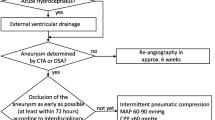Abstract
We report the case of a young woman affected by an aneurysmal subarachnoid haemorrhage (SAH) and numerous anatomic abnormalities. A Transcranial Colour-Coded Duplex Sonography, performed with the aim of monitoring the vasospasm, showed a non-pulsatile flow with loss of sharp systolic peak and lowering of mean flow velocities in the right extracranial Internal Carotid Artery (ICA) and all its intra-cranial branches. This event suggested a possible concomitant acute right ICA sub-occlusion with a lack of collateral circulation. This type of flow is typically found in systemic and brain arteries of patients undergoing to venous–arterial extracorporeal membrane oxygenation or to left ventricular assist devices. The absence of an adequate cerebral collateral circulation might be the explanation for this type of atypical flow. Aneurysms and arterial dissections contribute to SAH and ischemic stroke events, leading to long-term physical and cognitive disability. In our case, the prompt neurosonological diagnosis leaded to patient’s good outcome.






Similar content being viewed by others
References
Blanco P, Blaivas M (2017) Applications of transcranial color-coded sonography in the emergency department. J Ultrasound Med 36(6):1251–1266. https://doi.org/10.7863/ultra.16.04050
Connolly ES Jr, Rabinstein AA, Carhuapoma JR et al (2012) Guidelines for the management of aneurysmal subarachnoid hemorrhage: a guideline for healthcare professionals from the American Heart Association/American Stroke Association. Stroke 43:1711–1737
Sharma S, Lubrica RJ, Song M, Vandse R, Boling W, Pillai P (2020) The role of transcranial doppler in cerebral vasospasm: a literature review. Acta Neurochir Suppl 127:201–205. https://doi.org/10.1007/978-3-030-04615-6_32
Southerland AM, Green IE, Worrall BB (2021) Cerebral aneurysms and cervical artery dissection: Neurological complications and genetic associations. Handb Clin Neurol 177:241–251. https://doi.org/10.1016/B978-0-12-819814-8.00033-0
Hunt WE, Hess RM (1968) Surgical risk as related to time of intervention in the repair of intracranial aneurysms. J Neurosurg 28(1):14–20. https://doi.org/10.3171/jns.1968.28.1.0014
Drake CG (1988) Report of world federation of neurological surgeons committee on a universal subarachnoid hemorrhage Grading Scale. J Neurosurg 68(6):985–6. https://doi.org/10.3171/jns.1988.68.6.0985
Fisher CM, Kistler JP, Davis JM (1980) Relation of cerebral vasospasm to subarachnoid hemorrhage visualized by computerized tomographic scanning. Neurosurgery 6(1):1–9. https://doi.org/10.1227/00006123-198001000-00001
Bouthillier A, van Loveren HR, Keller JT (1996) Segments of the internal carotid artery: a new classification. Neurosurgery 38(3):425–432. https://doi.org/10.1097/00006123-199603000-00001 (discussion 432-3)
Macdonald RL (2014) Delayed neurological deterioration after subarachnoid haemorrhage. Nat Rev Neurol 10(1):44–58. https://doi.org/10.1038/nrneurol.2013.246
Debette S, Leys D (2009) Cervical-artery dissections: predisposing factors, diagnosis, and outcome. Lancet Neurol 8(7):668–678. https://doi.org/10.1016/S1474-4422(09)70084-5
Veraar CM, Rinösl H, Kühn K, Skhirtladze-Dworschak K, Felli A, Mouhieddine M, Menger J, Pataraia E, Ankersmit HJ, Dworschak M (2019) Non-pulsatile blood flow is associated with enhanced cerebrovascular carbon dioxide reactivity and an attenuated relationship between cerebral blood flow and regional brain oxygenation. Crit Care 23:426. https://doi.org/10.1186/s13054-019-2671-7
Purohit SN, Cornwell WK, Pal JD, Lindenfeld J, Ambardekar AV (2018) Living without a pulse: the vascular implications of continuous-flow left ventricular assist devices. Circ Heart Fail 11(6):e004670. https://doi.org/10.1161/CIRCHEARTFAILURE.117.004670
Stöhr EJ, McDonnell BJ, Colombo PC, Willey JZ (2019) Cross Talk proposal: blood flow pulsatility in left ventricular assist device patients is essential to maintain normal brain physiology. J Physiol 597:353–356. https://doi.org/10.1113/JP276729
Funding
The authors declare that no funds, grants, or other supports were received during the preparation of this manuscript.
Author information
Authors and Affiliations
Contributions
FP collaborated in writing manuscript and searching references. IS, performed and interpreted Transcranial Color-Codex Sonography and collaborated to figures preparation. GF collaborated to figures preparation and interpreted Neuroimaging. SC, IMV and VB analysed, interpreted Neuroimaging, and collaborated to manuscript revisions. RT performed and interpreted Transcranial Color-Codex Sonography exams and gave the main contribution to manuscript preparation and revisions. All authors read and approve the final manuscript.
Corresponding author
Ethics declarations
Conflict of interest
The authors have no relevant financial or non-financial interests to disclose.
Ethical approval
The Ethics Board at the Area Vasta Sud-Est of Tuscany, Italy, approved this study.
Consent to participate
Written informed consent was obtained from the patient.
Consent to publish
The authors affirm that patient provided informed consent for publication of the case report and images.
Additional information
Publisher's Note
Springer Nature remains neutral with regard to jurisdictional claims in published maps and institutional affiliations.
Rights and permissions
About this article
Cite this article
Parodi, F., Severi, I., Flora, G. et al. Concurrent subarachnoid haemorrhage and internal carotid artery dissection: a transcranial colour-coded sonography diagnosis. J Ultrasound 26, 771–776 (2023). https://doi.org/10.1007/s40477-022-00686-z
Received:
Accepted:
Published:
Issue Date:
DOI: https://doi.org/10.1007/s40477-022-00686-z




